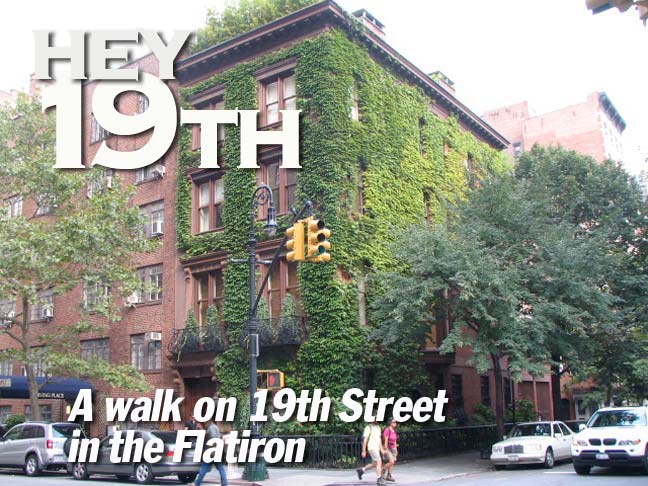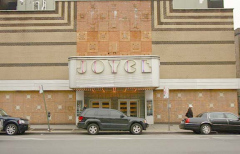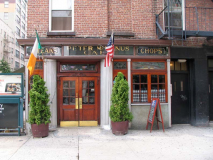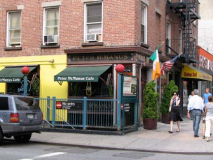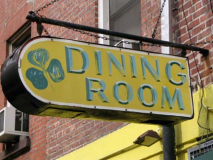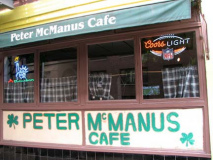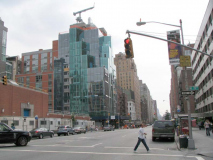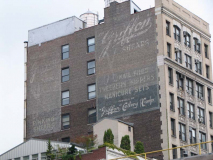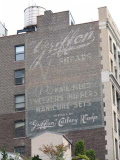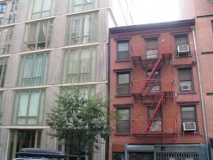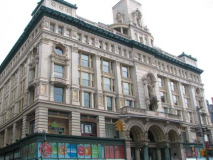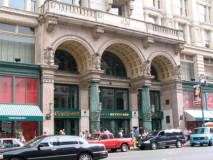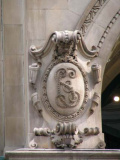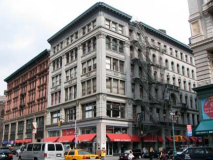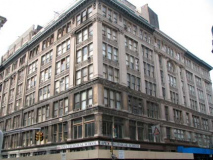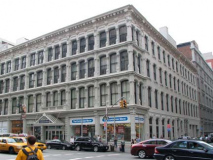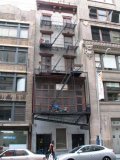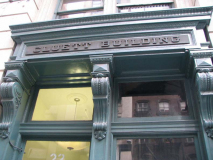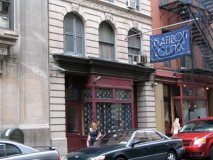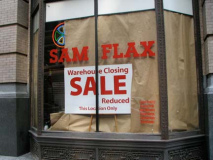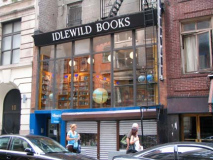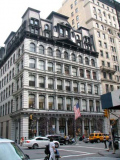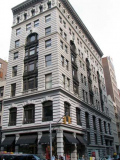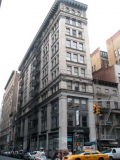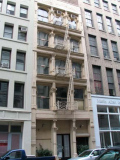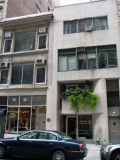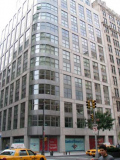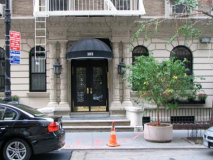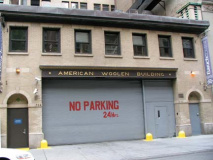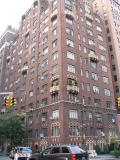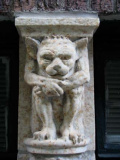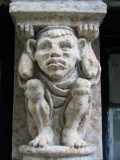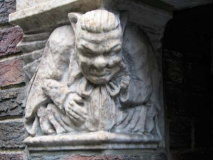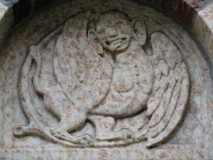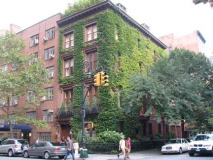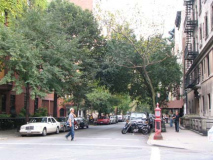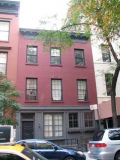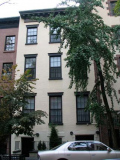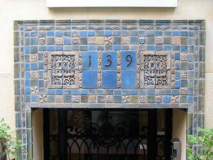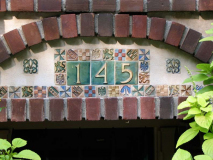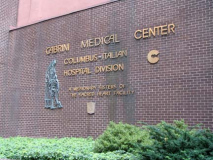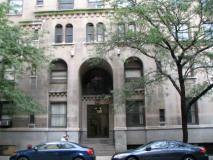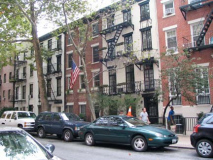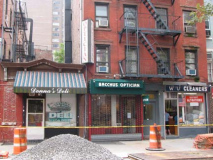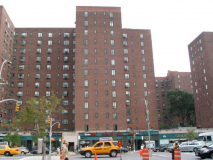In mid-September 2008 I embarked on my first Forgotten mission after a brief, but horrendous battle with a stomach flu of some kind that struck on September 11th, of all dates, a couple of hours after a meal of baked chicken and boiled frozen vegetables. (Even now, in mid-October, your webmaster hasn’t returned to frozen corn, beans or peas, but I know I have to eventually for the sake of health; I have been depending on salads for vegetative intake). So, I opted for a relatively brief hike on 19th Street, which I had found interesting some monhs back and filed a mental note to revisit. Not only did I find interesting architectural elements, but also some oblique references to my own life, as we’ll see…
The Joyce Theatre, at 8th Avenue and 19th, is a 472-seat dance performace venue opened in 1982 in the renovated and remodeled Elgin Theatre, opened in 1942, that had come on hard times in the 1970s as a porno palace — the renovation was suprvised by architect Hugh Hardy, whose Radio City Music Hall tour I attended — he revived RCMH as well — as part of Open House NY in 2008.
Your webmaster is not a ballet or modern dance fan, but I note the theatre because it is named for one of the founders of one of my workplaces. Joyce Mertz-Gilmore along with her parents, Harold and LuEsther Mertz, founded Publishers Clearing House, the premier direct marketing company in the country, in their basement in Sands Point, NY, in 1953. photo: wikipedia
The Joyce Theatre exists in great part due to the philanthropic efforts of LuEsther Mertz.
Directly across the Joyce, on 8th Avenue and 19th, was a Blimpie where I would get lunch once a week while employed at an international-language typesetter, ANY Phototype, on West 29th. In June 1990 I acquired one of my worst-ever stomach flus (until this year) at that Blimpie. Look, it made me remember the place. It was decorated unusually: it was filled with house plants.
I’ve only been in the Peter McManus Cafe, at 7th Avenue and W. 19th, once — in 1993, I had just gotten out of class at the School of Visual Arts, went in and called a friend to meet me there, whence we went to see The Fugitive, the Harrison Ford version. (I had a splitting headache that day.)
McManus looks as if it has been here forever, but it isn’t nearly as old as, say, the Old Town Bar or the granddaddy, McSorley’s Ale House. It has been owned and operated by the McManus family since it opened in 1936.
Looking south on 7th Avenue toward the old Barney’s. Several new residential towers have appeared on this stretch in the last few years (not at the fever pitch of 6th Avenue in the West 20s, though). Dominating the landscape is the new Coke bottle-green-glass-clad Yves Chelsea tower at West 18th. The penthouse will go for $10M, at least it was going to before all the Wall Street hotshots, bankers, and ill-advised real estate buyers tanked the economy.
Speaking of the economy, the last time your webmaster was out of work, all my unemployment check arrangements were handled electronically and there was less of a need to cut up paperwork before throwing it away. Nevertheless there will always be a neeed for scissors and shears, and that’s where Griffon came in. According to faded ad historian Walter Grutchfield, the Griffon Cutlery Works was founded by Albert Silberstein in 1888 and was located here on West 19th between 1920 and 1968. As you can see from the link the ad was in much better shape in 1986, and time is gradually taking a toll.
Note the palimpsest at the bottom. The company changed from “Works” to “Corporation” in the 1940s and painted over Works with Corp. Both are showing up now.
This sign is also an “example” of unnecessary quotation “marks.” They’re all over the place.
Pinking shears, by the way, are shears with jagged edges, used to cut thick cloth.
2008, meet 1908 along the south side of West 19th just east of 7th Avenue.
The Henry Siegel-Frank Cooper Dry Goods store, built in 1895 and in business until 1914, is the largest of the 6th Avenue Ladies’ Mile emporia, containing 15.5 acres of floor space. It used to have a clock tower as well as a large fountain, since removed and placed in Forest Lawn Cemetery in Los Angeles. A ramp from the old Sixth Avenue El (razed in 1938) allowed passengers to walk directly into the store from the platform on the 18th Street side. This is Beaux Arts at its most Beaux.
The store pioneered the use of free samples, female salespersons, and air conditioning as customer inducements, and one of its mottoes was “Everything Under The Sun.” Industrialist/barbed-wire king John Warne Gates once made a bet with financier J. P. Morgan that the boast was just rhetorical. Gates asked a floorwalker if the store sold elephants, whereupon he was directed to the toy department; Gates responded that he meant a real elephant. The representative asked him what color, Gates responded “white” and the answer was “we’ll let you know the delivery date.” A few weeks later Gates received a telegram informing him his order would be arriving the next day at the docks: an albino elephant shipped from Ceylon. Gates paid Morgan the bet and donated the pachyderm to the Central Park Zoo.
I see something new every time I pass or enter the Siegel-Cooper building. For example, here is one of the intertwined S/C’s that flank the arched entrance.
All 4 corners of West 19th and 6th are held down bu beautiful buildings of varying beauty and fame. On the NW corner (above right) is the Simpson-Crawford Building, constructed in 1900 and home to the titular store until 1915. The store popularized the phrase, “if you have to ask the price, you can’t afford it” and indeed the store eschewed the use of sales tags.
A Greek Revival building on the NE corner (above right) is home to a Sports Authority. Paragon, on Broadway between East 17th and 18th Streets since 1908, is the big sports dog in the area.
At the SW corner (left) we see the first Benjamin Altman Building from 1876-1906, whereupon the store moved to a massive building that filled an entire block between 5th, Madison, East 34th and East 35th Streets, where it was in business for the following 83 years. Altman opened his first store at 3rd Avenue and east 10th Street in 1865.
At a time when real estate has gotten so prohibitively expensive that even big retailers like Barnes and Noble are forced out by high rents (as they were from their 6th Avenue and West 22nd Street location in 2008) it’s comforting to know that Apex Tech is still holding down the corner plot on West 19th. The school offers training in automotive, refrigeration, electrical, plumbing, carpentry, welding and auto repair since 1961.
Throughout the 1980s, when local channels 5, 9 and 11 were independently owned and showed mostly reruns and movies, the Apex tech commercials featuring the mustachioed Apex Tech Guy were a staple. His catchphrase was “Now, I can’t call you…”
Naturally, he doesn’t utter the famous phrase in this vintage Apex tech spot, but you get the idea…
A couple of midblock views between 5th and 6th Avenues. 35 West 19th, on the right, now home to Sala, a Spanish restaurant, is notable for being the longtime home of The Magickal Childe, ostensibly an occult bookstore but also featuring hexerei of the weird such as voodoo dolls, herbs used in potions, tarot cards and wicca (not witchcraft to devotees) paraphernalia. The Charmed girls would have fit right in.
The Cluett Building at 22-28 West 19th runs right through the block to 19-23 West 18th. The name of the building stirred a memory. Walter Grutchfield: The building was constructed in 1901/02 as the New York headquarters of Cluett, Peabody & Co. of Troy, NY. They were collar manufacturers and created the Arrow brand of detachable shirt collars. According to the Free Dictionary, “About 1905 the company began an advertising campaign that featured an idyllic young man wearing an Arrow shirt with the detached collar… Hundreds of printed advertisements were produced from 1907 to 1930 featuring the Arrow Collar Man. The fictional Arrow collar man became an icon and by 1920 received more than 17 thousand fan letters a day.”
I had to reach deep in the ForgottenArchives for this: Cluett, Peabody was a name I heard frequently in youth; both my grandmother and my mother (who I indicated, at left, in the photo of a company gathering that I’d estimate was from the early 1950s) worked at the Troy, NY company in the 1940s and 1950s.
Free Dictionary again: In the early 1920’s Cluett, Peabody & Co. began manufacturing their shirts with attached collars in response to consumer demand and became the most successful company in the U.S. at that time. Their sales increased to 4 million collars a week and arrow shirts with attached collars were being exported to foreign ports such as Jakarta, Indonesia, Java and the Belgian Congo. The Arrow Collar Man campaign ended in 1930 having been one of the most successful advertising campaigns in history.
My mother, of course, is the most attractive woman in the picture.
The Flatiron Lounge at 37 West 19th takes its name, of course, from the famed Fuller (Flatiron) Building at 5th Avenue, Broadway and 23rd Street.
I’m rarely in Sam Flax but only because I fear that when I’m in here, I’ll spend too much. Flax is second only to Pearl Paint in providing art supplies and everything necessary for putting pen or brush to paper. I hope its locale between 19th and 20th Streets west of 5th Avenue isn’t closing.
LEFT: Idlewild Books, a new travel book store, has become one of my new favorites (especially since the ForgottenBook is displayed prominently within). “Idlewild” was the old name for John F. Kennedy International Airport. Good luck, though, in the shadow of the Barnes and Noble flagship at 5th and East 18th.
At the SE corner of 5th Avenue and West 19th is the Arnold, Constable Building, yet another former department store.
Jim Naureckas, NY Songlines:
Nine West, Victoria’s Secret are in former department store (1869-1914) that took up the entire block from 5th to 6th avenues; founded by Aaron Arnold and son-in-law James Constable, it offered “Everything From Cradle to Grave.” Mary Todd Lincoln was a frequent customer, as well as Carnegies, Rockefellers and Morgans.
Another Constable building can be found on Canal Street.
Briton Arthur Arnold opened a dry goods store in 1825 and took on James Constable as a partner in 1842. After the firm thrived for over a century, the last Arnold Constable store, at 5th Avenue and 40th Street, closed in 1975. (The comma, like the New York Times period, has disappeared along the way, so latterday customers thought an Arnold Constable was the original shopkeeper.)
Two narrow 1900-era towers flank West 19th Street at 5th Avenue. The building on the right was the longtime home of Weiss & Mahoney Army & Navy store and the former locale of the 5th Avenue Presbyterian Church (1852-1875). Your webmaster’s first job out of school was in 150 5th Avenue, a block away on 20th.
A pair of great escapes on East 19th between 5th Avenue and Broadway.
ABOVE: ABC Carpet, SE corner Broadway and East 19th, formerly W&J Sloane Furniture. RIGHT: contrast 35 and the Modernist 37 East 19th. 35 was the residence of Horace Greeley, editor, abolitionist and politician, from 1850-1853.
LEFT: NW corner Park Avenue South and East 19th, new tower tries for a Starrett-Lehigh vibe but doesn’t quite get there; I prefer the Doric-columned neo Renaissance apartment building at 105.
The American Woolen Building actually is entered on 221-227 Park Avenue South (marked with a ram’s head), while this, at 102-104 East 19th, is the freight entrance.
I’ve always loved the corner apartment building at 81 Irving Place and 123 East 19th — it’s festooned with dozens of terra cotta gnomes. And more gnomes.
For this 14-story apartment house, architect George Pelham, one of New York’s most active apartment-house designers, exploited the requirements of the zoning law to create an exuberant design [in 1929-1930] with dramatic setbacks and a striking rooftop pavilion surrounding the water tower. The building, planned with 107 small apartments, is faced with brick, often laid in intricate patterns to add excitement to the facades. The building is ornamented wth beige terra-cotta detail of a very high quality. Terra-cotta features include columns, balconies, and gargoyles embellished with animal heads, monsters, and other fanciful detail. NYC Architecture
The figure below right seems to be influenced by cartoonist R.F. Outcault’s 1890s creation, the Yellow Kid.
East 19th changes character, rather abruptly, for the block between Irving Place and 3rd Avenue and transforms itself into a tree-lined, suburban-style stretch dotted with small brick buildings, carriage houses and cottages. The tone is set by the ivy-covered NE corner building. Pete’s Tavern is one block south of here at East 18th.
In the early 20th Century the creative community had a great presence on this block, which was home to actresses Theda Bara, Dorothy and Lillian Gish, Ethel Barrymore and Helen Hayes; playwrights, authors and activists F. Scott Fitzgerald, John Reed, Emma Goldman and Eugene O’Neill were visitors.
There’s some riotous terra cotta tilework on the north side of the block; much of it is the work of architect Frederick Sterner and artist Richard Winthrop Chandler.
146 East 19th was home to painter George Bellows from 1910-1925, a man who lived the high life. “I went there in the evening a young girl and came away in the morning an old woman,” as Ethel Barrymore once said. Bellows, along with Edward Hopper, studied under Robert Henri at the NY School of Art and became a luminary in the modernistic Ashcan School. Possibly Bellows’ most famous painting was his depiction of Luis Firpo (“The Wild Bull of the Pampas”) knocking Jack Dempsey through the ropes in the first round in a 1923 fight. Dempsey recovered to KO Firpo in the second round. Artist Eric Joyner does a takeoff on Bellows’ vision in The Final Blow.
At 226 3rd Avenue on the NW corner is a terrific painted sign for the Piccolo restaurant.
The block of East 19th between 3rd and 2nd Avenues is dominated by the rather forbidding Mother Cabrini Medical Center, originally Columbus Hospital. Andy Warhol was treated here when he was shot by Valerie Solanas in 1968.
Saint Frances Xavier Cabrini (1850-1917), the first US Citizen to be canonized as a saint by the Roman Catholic Church, founded the Missionary Sisters of the Sacred Heart and established 67 orphanages throughout the USA , South America and Europe. Since 1931 her preserved remains have been displayed at Mother Cabrini Shrine in Fort Washington in upper Manhattan on a street named in her honor, Cabrini Boulevard.
Some bits of an increasingly retreating Little Old New York in the easternmost segment of East 19th, between 2nd and 1st Avenues.
We’ve already seen an item on 19th Street that reminded me of my mother. Here’s one that reminds me of the old man, who worked at Stuyvesant Town from 1955-1988 as a custodian. The apartment complex was constructed in the 1947 by Metropolitan Life Insurance Company; Peg Leg Pete, the Director-General of New Amsterdam, lived in this site on his farm in the late 1600s. It was championed by Robert Moses as part of his slum-clearance program in mid-century. When first opened, the complex would not rent to African-Americans, and the discrimination was held up in court. “Stuy Town” reversed the policy several years later. For many years, though the project didn’t have the necessary wiring for air conditioning, the waiting list for an apartment was quite long. The list was abolished when Met Life set about converting and upgrading the apartments to market rents beginning in 2006. Your webmaster foolishly never asked to get on “the list”, though Stuy Town would no doubt be trying to get my rent stabilized self out if I lived there now!

